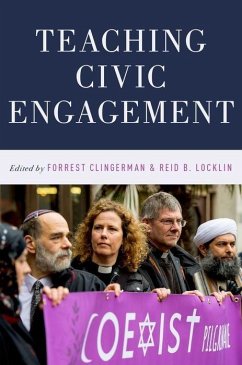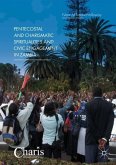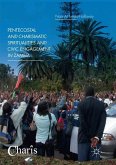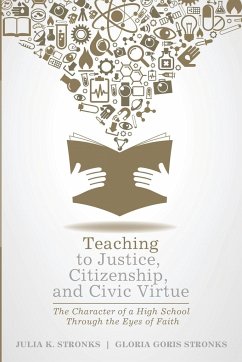Teaching Civic Engagement
Herausgeber: Clingerman, Forrest; Locklin, Reid B
Teaching Civic Engagement
Herausgeber: Clingerman, Forrest; Locklin, Reid B
- Gebundenes Buch
- Merkliste
- Auf die Merkliste
- Bewerten Bewerten
- Teilen
- Produkt teilen
- Produkterinnerung
- Produkterinnerung
Teaching Civic Engagement offers a new conceptual model, an examination of theoretical questions and concerns, and a variety of concrete teaching strategies to assist faculty in engaging questions of civic belonging and social activism in religion classrooms. The book explores the civic relevance of the academic study of religion.
Andere Kunden interessierten sich auch für
![Teaching Civic Engagement Teaching Civic Engagement]() Teaching Civic Engagement40,99 €
Teaching Civic Engagement40,99 €![Pentecostal and Charismatic Spiritualities and Civic Engagement in Zambia Pentecostal and Charismatic Spiritualities and Civic Engagement in Zambia]() Naar M'Fundisi-HollowayPentecostal and Charismatic Spiritualities and Civic Engagement in Zambia67,99 €
Naar M'Fundisi-HollowayPentecostal and Charismatic Spiritualities and Civic Engagement in Zambia67,99 €![Pentecostal and Charismatic Spiritualities and Civic Engagement in Zambia Pentecostal and Charismatic Spiritualities and Civic Engagement in Zambia]() Naar M'fundisi-HollowayPentecostal and Charismatic Spiritualities and Civic Engagement in Zambia67,99 €
Naar M'fundisi-HollowayPentecostal and Charismatic Spiritualities and Civic Engagement in Zambia67,99 €![Teaching to Justice, Citizenship, and Civic Virtue Teaching to Justice, Citizenship, and Civic Virtue]() Julia K. StronksTeaching to Justice, Citizenship, and Civic Virtue18,99 €
Julia K. StronksTeaching to Justice, Citizenship, and Civic Virtue18,99 €![Integrating Ecofeminism, Globalization, and World Religions Integrating Ecofeminism, Globalization, and World Religions]() Rosemary Radford RuetherIntegrating Ecofeminism, Globalization, and World Religions138,99 €
Rosemary Radford RuetherIntegrating Ecofeminism, Globalization, and World Religions138,99 €![Korean American Evangelicals New Models for Civic Life Korean American Evangelicals New Models for Civic Life]() Elaine Howard EcklundKorean American Evangelicals New Models for Civic Life43,99 €
Elaine Howard EcklundKorean American Evangelicals New Models for Civic Life43,99 €![Catholic Higher Education Catholic Higher Education]() Melanie M. MoreyCatholic Higher Education100,99 €
Melanie M. MoreyCatholic Higher Education100,99 €-
-
-
Teaching Civic Engagement offers a new conceptual model, an examination of theoretical questions and concerns, and a variety of concrete teaching strategies to assist faculty in engaging questions of civic belonging and social activism in religion classrooms. The book explores the civic relevance of the academic study of religion.
Hinweis: Dieser Artikel kann nur an eine deutsche Lieferadresse ausgeliefert werden.
Hinweis: Dieser Artikel kann nur an eine deutsche Lieferadresse ausgeliefert werden.
Produktdetails
- Produktdetails
- Verlag: Oxford University Press
- Seitenzahl: 336
- Erscheinungstermin: 4. Januar 2016
- Englisch
- Abmessung: 236mm x 163mm x 30mm
- Gewicht: 544g
- ISBN-13: 9780190250508
- ISBN-10: 019025050X
- Artikelnr.: 47863423
- Herstellerkennzeichnung
- Libri GmbH
- Europaallee 1
- 36244 Bad Hersfeld
- gpsr@libri.de
- Verlag: Oxford University Press
- Seitenzahl: 336
- Erscheinungstermin: 4. Januar 2016
- Englisch
- Abmessung: 236mm x 163mm x 30mm
- Gewicht: 544g
- ISBN-13: 9780190250508
- ISBN-10: 019025050X
- Artikelnr.: 47863423
- Herstellerkennzeichnung
- Libri GmbH
- Europaallee 1
- 36244 Bad Hersfeld
- gpsr@libri.de
Forrest Clingerman is Associate Professor of Religion and Philosophy at Ohio Northern University. He is co-editor of Interpreting Nature: The Emerging Field of Environmental Hermeneutics (2013) and Placing Nature on the Borders of Religion, Philosophy and Ethics (2011). He has published on different topics related to environmental theology and philosophy, as well as in the scholarship of teaching and learning. Reid B. Locklin holds a joint appointment in Christianity and Culture at Saint Michael's College and the Department for the Study of Religion at the University of Toronto. He is the author of Spiritual but Not Religious? (2005); Liturgy of Liberation (2011); and other works in comparative theology, Hindu-Christian studies, and the scholarship of teaching and learning.
* Contributors
* Introduction
* Section I: What are the Dimensions of Teaching Civic Engagement in
the Religious Studies or Theology Classroom?
* Chapter 1: Reid B. Locklin, with Ellen Posman, Discourse, Democracy,
and the Many Faces of Civic Engagement: Four Guiding Objectives for
the University Classroom
* Chapter 2: Ellen Posman, with Reid B. Locklin, Sacred Sites and
Staging Grounds: The Four Guiding Objectives of Civic Engagement in
the Religion Classroom
* Section II: What Practical Strategies and Questions Emerge from
Teaching Civic Engagement in Religious Studies and Theology?
* Chapter 3: Melissa Stewart, Teaching for Civic Engagement: Insights
from a Two-Year Workshop
* Chapter 4: Marianne Delaporte, Giving and Receiving Hospitality
during Community Engagement Courses
* Chapter 5: Rebekka King, Civic Engagement in the Heart of the City
* Chapter 6: Hans Wiersma, Engaging Media and Messages in the Religion
Classroom
* Chapter 7: Phil Wingeier-Rayo, Service and Community-Based Learning:
A Pedagogy for Civic Engagement and Critical Thinking
* Chapter 8: Nicholas Rademacher, Religious Diversity, Civic Engagement
and Community-Engaged Pedagogy: Forging Bonds of Solidarity through
Interfaith Dialogue
* Chapter 9: Elizabeth W. Corrie, Stopping the Zombie Apocalypse:
Ascetic Withdrawal as a Form of Civic Learning
* Section III: What are the Theoretical Issues and Challenges in
Teaching Civic Engagement in Religious Studies and Theology?
* Chapter 10: Carolyn M. Jones Medine, Thinking about the 'Civic' in
Civic Engagement and Its Deployment in the Religion Classroom
* Chapter 11: Karen Derris and Erin Runions, More than Global
Citizenship: How Religious Studies Expands Participation in Global
Communities
* Chapter 12: Forrest Clingerman and Swasti Bhattacharyya, Political
Involvement, the Advocacy of Process, and the Religion Classroom
* Chapter 13: Tom Pearson, The Difference between Religious Studies and
Theology in the Teaching of Civic Engagement
* Chapter 14: Tina Pippin, Dreams of Democracy
* Introduction
* Section I: What are the Dimensions of Teaching Civic Engagement in
the Religious Studies or Theology Classroom?
* Chapter 1: Reid B. Locklin, with Ellen Posman, Discourse, Democracy,
and the Many Faces of Civic Engagement: Four Guiding Objectives for
the University Classroom
* Chapter 2: Ellen Posman, with Reid B. Locklin, Sacred Sites and
Staging Grounds: The Four Guiding Objectives of Civic Engagement in
the Religion Classroom
* Section II: What Practical Strategies and Questions Emerge from
Teaching Civic Engagement in Religious Studies and Theology?
* Chapter 3: Melissa Stewart, Teaching for Civic Engagement: Insights
from a Two-Year Workshop
* Chapter 4: Marianne Delaporte, Giving and Receiving Hospitality
during Community Engagement Courses
* Chapter 5: Rebekka King, Civic Engagement in the Heart of the City
* Chapter 6: Hans Wiersma, Engaging Media and Messages in the Religion
Classroom
* Chapter 7: Phil Wingeier-Rayo, Service and Community-Based Learning:
A Pedagogy for Civic Engagement and Critical Thinking
* Chapter 8: Nicholas Rademacher, Religious Diversity, Civic Engagement
and Community-Engaged Pedagogy: Forging Bonds of Solidarity through
Interfaith Dialogue
* Chapter 9: Elizabeth W. Corrie, Stopping the Zombie Apocalypse:
Ascetic Withdrawal as a Form of Civic Learning
* Section III: What are the Theoretical Issues and Challenges in
Teaching Civic Engagement in Religious Studies and Theology?
* Chapter 10: Carolyn M. Jones Medine, Thinking about the 'Civic' in
Civic Engagement and Its Deployment in the Religion Classroom
* Chapter 11: Karen Derris and Erin Runions, More than Global
Citizenship: How Religious Studies Expands Participation in Global
Communities
* Chapter 12: Forrest Clingerman and Swasti Bhattacharyya, Political
Involvement, the Advocacy of Process, and the Religion Classroom
* Chapter 13: Tom Pearson, The Difference between Religious Studies and
Theology in the Teaching of Civic Engagement
* Chapter 14: Tina Pippin, Dreams of Democracy
* Contributors
* Introduction
* Section I: What are the Dimensions of Teaching Civic Engagement in
the Religious Studies or Theology Classroom?
* Chapter 1: Reid B. Locklin, with Ellen Posman, Discourse, Democracy,
and the Many Faces of Civic Engagement: Four Guiding Objectives for
the University Classroom
* Chapter 2: Ellen Posman, with Reid B. Locklin, Sacred Sites and
Staging Grounds: The Four Guiding Objectives of Civic Engagement in
the Religion Classroom
* Section II: What Practical Strategies and Questions Emerge from
Teaching Civic Engagement in Religious Studies and Theology?
* Chapter 3: Melissa Stewart, Teaching for Civic Engagement: Insights
from a Two-Year Workshop
* Chapter 4: Marianne Delaporte, Giving and Receiving Hospitality
during Community Engagement Courses
* Chapter 5: Rebekka King, Civic Engagement in the Heart of the City
* Chapter 6: Hans Wiersma, Engaging Media and Messages in the Religion
Classroom
* Chapter 7: Phil Wingeier-Rayo, Service and Community-Based Learning:
A Pedagogy for Civic Engagement and Critical Thinking
* Chapter 8: Nicholas Rademacher, Religious Diversity, Civic Engagement
and Community-Engaged Pedagogy: Forging Bonds of Solidarity through
Interfaith Dialogue
* Chapter 9: Elizabeth W. Corrie, Stopping the Zombie Apocalypse:
Ascetic Withdrawal as a Form of Civic Learning
* Section III: What are the Theoretical Issues and Challenges in
Teaching Civic Engagement in Religious Studies and Theology?
* Chapter 10: Carolyn M. Jones Medine, Thinking about the 'Civic' in
Civic Engagement and Its Deployment in the Religion Classroom
* Chapter 11: Karen Derris and Erin Runions, More than Global
Citizenship: How Religious Studies Expands Participation in Global
Communities
* Chapter 12: Forrest Clingerman and Swasti Bhattacharyya, Political
Involvement, the Advocacy of Process, and the Religion Classroom
* Chapter 13: Tom Pearson, The Difference between Religious Studies and
Theology in the Teaching of Civic Engagement
* Chapter 14: Tina Pippin, Dreams of Democracy
* Introduction
* Section I: What are the Dimensions of Teaching Civic Engagement in
the Religious Studies or Theology Classroom?
* Chapter 1: Reid B. Locklin, with Ellen Posman, Discourse, Democracy,
and the Many Faces of Civic Engagement: Four Guiding Objectives for
the University Classroom
* Chapter 2: Ellen Posman, with Reid B. Locklin, Sacred Sites and
Staging Grounds: The Four Guiding Objectives of Civic Engagement in
the Religion Classroom
* Section II: What Practical Strategies and Questions Emerge from
Teaching Civic Engagement in Religious Studies and Theology?
* Chapter 3: Melissa Stewart, Teaching for Civic Engagement: Insights
from a Two-Year Workshop
* Chapter 4: Marianne Delaporte, Giving and Receiving Hospitality
during Community Engagement Courses
* Chapter 5: Rebekka King, Civic Engagement in the Heart of the City
* Chapter 6: Hans Wiersma, Engaging Media and Messages in the Religion
Classroom
* Chapter 7: Phil Wingeier-Rayo, Service and Community-Based Learning:
A Pedagogy for Civic Engagement and Critical Thinking
* Chapter 8: Nicholas Rademacher, Religious Diversity, Civic Engagement
and Community-Engaged Pedagogy: Forging Bonds of Solidarity through
Interfaith Dialogue
* Chapter 9: Elizabeth W. Corrie, Stopping the Zombie Apocalypse:
Ascetic Withdrawal as a Form of Civic Learning
* Section III: What are the Theoretical Issues and Challenges in
Teaching Civic Engagement in Religious Studies and Theology?
* Chapter 10: Carolyn M. Jones Medine, Thinking about the 'Civic' in
Civic Engagement and Its Deployment in the Religion Classroom
* Chapter 11: Karen Derris and Erin Runions, More than Global
Citizenship: How Religious Studies Expands Participation in Global
Communities
* Chapter 12: Forrest Clingerman and Swasti Bhattacharyya, Political
Involvement, the Advocacy of Process, and the Religion Classroom
* Chapter 13: Tom Pearson, The Difference between Religious Studies and
Theology in the Teaching of Civic Engagement
* Chapter 14: Tina Pippin, Dreams of Democracy








